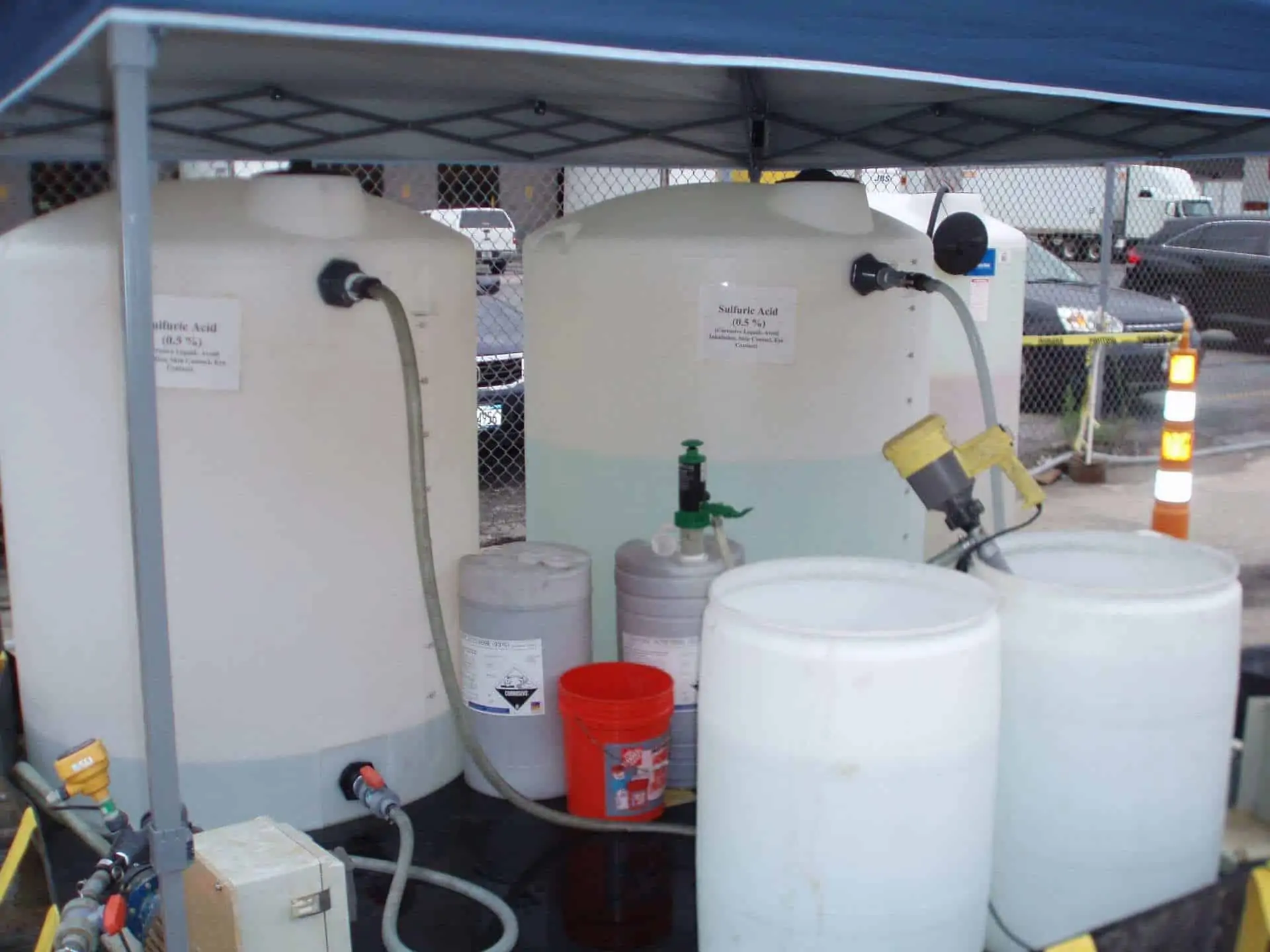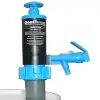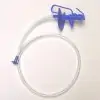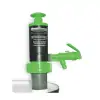Recommended by several chemical companies, there is no doubt that GoatThroat® Pumps improve reliability and safety in a public water supply environment. Users all agree that spill prevention beats clean up with solvents, acids, and other corrosives. With the cost of chemicals, many facilities use GT Pumps because they are safe for contact with over 1700 chemicals and meet exacting requirements. The sealed system is essential in such environments because it reduces vapors and emissions and allows for complete control over the volume of liquids dispensed. The SCP Line of Pumps which are made of static conductive plastic allows these pumps to be used with flammable liquids meeting both NFPA 77 and NFPA 30 requirements. All non-SCP pumps are made from Food Grade materials making them safe for food contact. GoatThroat Pumps’ unique technology help companies reduce hazmat incidents and save money at their facilities by preventing costly chemical spills and the associated cost of reporting and downtime. The systems mitigate worker compensation claims by preventing workers exposure to hazardous chemicals and by eliminating repetitive motion and other injuries.
Download Library.
Click on a title to download.
- Technical Article - Chemical Handling for Public Water Supply
- Feature article in Water and Wastewater News
- Groundwater remediation at JFK Airport
Recommended Products
Case Studies.
Ground Water and Soil Remediation at JFK Airport
Ground Water and Soil Remediation An Environmental Remediation Company was hired to remove contamination from soil and groundwater at John F. Kennedy Airport without excavation or continuous equipment on the site. Applying the most advanced technologies and contracting solutions, they restored contaminated soil and groundwater in the shortest possible time using GoatThroat Pumps. In the customer’s own words: “We are using the pump to dispense 93% sulfuric acid, which then is diluted in 500- gallon tanks to 0.5%. The dilute acid is pumped into the groundwater through injection wells within an area that has been impacted by petroleum compounds from old underground storage tank releases. The acid is used to lower the pH of the groundwater as a conditioning step prior to injection of dilute hydrogen peroxide as an oxidizing step, which breaks down the petroleum compounds. In the photos you can see the GT300 set up on 15-gal carboys …
Safe Chlorine handling for Iowa Water Supply
Safe Chemical Handling for Public Water Supply More than 2.5 million people in Iowa are served by public water supplies. According to the annual DNR compliance report, the 2,000 regulated water public supplies, have seen significant improvement in compliance with new rules which require systems to measure the byproducts of the disinfection process. The byproducts can have an effect on public health especially pregnant women, the elderly, children and people with a weakened immune system. These rules were put in place as part of new federal regulations which created more requirements or water system operators and state oversight staff. “Overall, the public water supplies in Iowa are serving safe water,” according to Dennis Alt, supervisor of the DNR’s water supply engineering section which monitors sampling and report of public water systems. “The drinking water industry is very complicated with many requirements. Iowa is fortunate to have dedicated, qualified water treatment …
No More Tipping and Tapping
Pesticide dispensing solution finds multiple applications at water and wastewater facility Killing weeds isn’t one of the primary responsibilities of a water and wastewater management facility, but it does require some care to do the job well and in compliance with California’s Title 3 Pesticide Regulations. The San Joaquin, Calif., water and wastewater management facility is located on 100 acres. It serves 1.5 million people, processing 1.5 gallons per day per person. Its wastewater treatment plant sits on 20 acres, where weeds grow along the perimeter. To keep growth at bay, staff members frequently applied Roundup®. The plant manager purchased the chemical in large drums and installed regular hand pumps to transfer the liquid into dispensing sprayers. This process was difficult and messy for employees and wasted chemical due to spillage. Within a few uses, the chemicals corroded the transfer pumps, which then had to be discarded into the landfill …
Ground Water and Soil Remediation at JFK Airport
Ground Water and Soil Remediation
An Environmental Remediation Company was hired to remove contamination from soil and groundwater at John F. Kennedy Airport without excavation or continuous equipment on the site. Applying the most advanced technologies and contracting solutions, they restored contaminated soil and groundwater in the shortest possible time using GoatThroat Pumps. In the customer’s own words:
“We are using the pump to dispense 93% sulfuric acid, which then is diluted in 500- gallon tanks to 0.5%. The dilute acid is pumped into the groundwater through injection wells within an area that has been impacted by petroleum compounds from old underground storage tank releases. The acid is used to lower the pH of the groundwater as a conditioning step prior to injection of dilute hydrogen peroxide as an oxidizing step, which breaks down the petroleum compounds. In the photos you can see the GT300 set up on 15-gal carboys of sulfuric. The big 500-gal dilution tanks are in the background. All of the mixing & dilution operations are conducted in Type C PPE and within a secondary containment device. Pumps and reinforced hose are used to distribute the dilute reagents to the injection wells up to 250-feet away. Within the various treatment areas there may be up to 20 or so injection points. The total quantity of reagent (acid + oxidizer) for all areas in this contract is approximately 200,000 gallons. Upon completion we will have used approx. 31 carboys of 93% sulfuric acid – equal to approx 470 gallons – with the GT300. Thanks again for helping us out.”
Safe Chlorine handling for Iowa Water Supply
Safe Chemical Handling for Public Water Supply
More than 2.5 million people in Iowa are served by public water supplies. According to the annual DNR compliance report, the 2,000 regulated water public supplies, have seen significant improvement in compliance with new rules which require systems to measure the byproducts of the disinfection process. The byproducts can have an effect on public health especially pregnant women, the elderly, children and people with a weakened immune system. These rules were put in place as part of new federal regulations which created more requirements or water system operators and state oversight staff.
“Overall, the public water supplies in Iowa are serving safe water,” according to Dennis Alt, supervisor of the DNR’s water supply engineering section which monitors sampling and report of public water systems. “The drinking water industry is very complicated with many requirements. Iowa is fortunate to have dedicated, qualified water treatment and water distribution system operators, and state drinking water oversight staff. And I’m sure we can work together to improve the compliance rate.”
One of the Water Districts delivers drinking water to almost 1000 customers who live about in one of the small towns in Iowa. The water comes from the local lakes and is piped out to the area. To ensure that the water is potable, chlorine is fed into the system twice a week at the well field before it reaches the booster station for the community. Recently, to save money, the District switched over from tablets to liquid chlorine. Because of the toxic nature of chlorine, the District had been purchasing the liquid in 5 gallon containers. Research by employees showed that purchasing the disinfecting agent in 55 gallon bulk containers saved quite a lot of money but made safe handling a problem. They found that once the drums of chlorine were tapped, workers were still left to deal with the inherent difficulties that gravity-fed spigot systems presented. First, extracting fluid was still very labor intensive and awkward. Spigots clogged easily and were difficult to remove. Second, it was difficult to control the flow rate, and the spigots leaked, contributing to spills and fugitive inventory loss. Finally, the spigot system did not allow complete removal of all fluid from the drum, so additional labor and handling were required by two people to dump out the drum to get the remaining fluid out.
Through additional research on the internet, the Metro District staff member discovered and purchased a GoatThroat Pump which created a very safe handling situation for the chlorine in 55 gallon drums. With these pumps, the containers remain upright, so there is no extra handling required for drums and no chance for accidental spills or lost work days. The pump’s working pressure of 1-5PSI produces consistent flow rate of 4.5gpm. A drip-proof faucet with finger tip control dispenses small amounts or gives steady flow. Having used the pumps since 2004, site operators have been very impressed with their pump. It has allowed them to decant chlorine safely and with no messy spills. Additionally, these pumps have spring loaded faucets which provide significant accuracy rate in the amount of fluids dispensed so there is no chance for uncontrolled addition of the chlorine into the system thereby eliminating the fear of excess chlorine byproducts in the water.
No More Tipping and Tapping
Pesticide dispensing solution finds multiple applications at water and wastewater facility
Killing weeds isn’t one of the primary responsibilities of a water and wastewater management facility, but it does require some care to do the job well and in compliance with California’s Title 3 Pesticide Regulations.
The San Joaquin, Calif., water and wastewater management facility is located on 100 acres. It serves 1.5 million people, processing 1.5 gallons per day per person. Its wastewater treatment plant sits on 20 acres, where weeds grow along the perimeter. To keep growth at bay, staff members frequently applied Roundup®.
The plant manager purchased the chemical in large drums and installed regular hand pumps to transfer the liquid into dispensing sprayers. This process was difficult and messy for employees and wasted chemical due to spillage. Within a few uses, the chemicals corroded the transfer pumps, which then had to be discarded into the landfill and replaced several times a year. Already, the hand pumps were not a good fit for this application, and soon state regulators had developed new guidelines.
California Title 3 Pesticide Regulations Sec. 6742.3 (Safe Equipment)
state that shut-off devices need to be installed on the exit end of all hoses carrying liquid pesticides in categories 1 and 2 to prevent splashes on employees and dripping when the filling operation is stopped. Sec. 6746 (Closed systems) requires connecting hoses, pipes, and couplings to remove a pesticide from its original container to guard against personal exposure.
Early in 2006, the plant manager knew he had to find a better solution. His research led him to a GoatThroat hand pump that pressurizes the drum and, through a remote discharge tap with finger-tipped controlled shut-off valve and 5 feet of flexible tubing, dispensed the Roundup® to the dispenser sprayer with no splashing.
That was two years ago, and the staff is not only still using that original pump for Roundup®, but management replaced pumps in six other chemical applications, including caustic soda used for cleaning bio-growth from diffuser blades and for d-limonene and petroleum-based degreasers.
“When you find something that works that well and saves you money, you immediately want to use it anywhere you can. The great thing is that the pumps allow staff to transfer fluids efficiently from upright 55-gallon drums. No more dangerous tipping and tapping,” the plant manager said.





